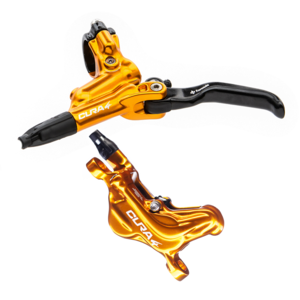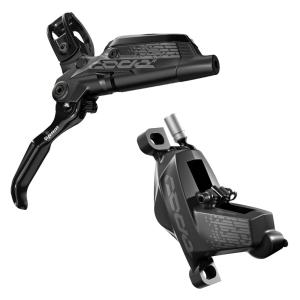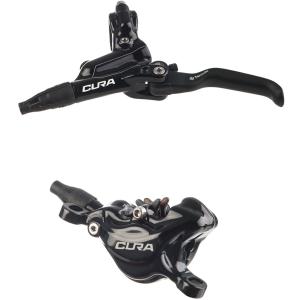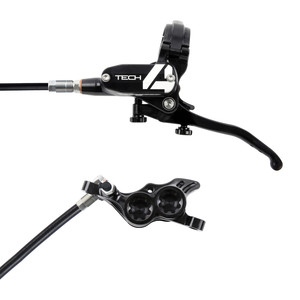TRP Quadiem G-Spec Disc Brake
(discontinued)
| Where To Buy | |||
|---|---|---|---|
Free shipping on orders over $50 (continental U.S. only).
International shipping available. Some exclusions apply. |
Free shipping on orders over $50 (continental U.S. only).
International shipping available. Some exclusions apply. $119.99
|
||
TRP Slate T4 Disc Brake
$119.99
|
|||
Free shipping on orders over $50 (continental U.S. only).
International shipping available. Some exclusions apply. |
Free shipping on orders over $50 (continental U.S. only).
International shipping available. Some exclusions apply. $32.99
|
||

IfTRP isn’t the first name that comes to mind when you think of brakes, you’re forgiven. Better known as Tektro, these brakes were historically sold on very low-end bikes, with nothing but a couple of rides and a one-way ticket to the parts bin to look forward to. No wonder that it took the world by surprise when in 2016 Aaron Gwin announced that he’d be asking TRP to supply him with brakes for his new World Cup downhill racing team, the YT Mob. Of course, Gwin wouldn’t consider such a move if he didn’t think he could win with the equipment in question, but we were still curious to find out just how good TRP’s latest stoppers are. If you are too, then keep reading!
TRP Quadiem G-Spec Highlights
- Four piston forged caliper
- Steel pistons with ceramic inserts for improved heat dissipation
- Indexed tool free reach adjust
- Available in polished anodized silver
- CNC caliper cooling fins
- Split hinge clamp
- I-Spec b, I-Spec ll (XT and XTR only) or matchmaker compatible with correct TRP adapter to match shifter
- Ergonomic dimpled and drilled alloy lever designed by Aaron Gwin
- 2-piece rotor (sold separately)
- Brake weight: 312g (front, verified, without rotor)
- Rotor weight: 170g (2-piece, 203mm)
- MSRP: $199 per side, excluding rotors and adapters
Initial Impressions
There is nothing understated about the Quadiem G-Spec. From the imposing size to the silver finish, these stoppers make their presence felt from the minute you open the box. Made from forged and CNCed aluminum, both the lever and the caliper have been polished to a shine. Additionally, the quality of the hardware and the general level of craftsmanship on display is evidence of TRP’s attention to detail when developing this high-end product. After all, it’s not every day you get to build a brake for a multiple World Cup champion.

The oversized, four-pot caliper is made in two pieces that bolt together, and features machined cooling fins and steel pistons with ceramic inserts to further improve heat management. The banjo can be rotated to help with brake hose alignment, and the pads load from the bottom (from the disc side).


The R/L-specific lever features a large oil reservoir to help improve consistency as the brake pads wear. The lever shape and even the drilling were developed directly with Gwin to meet his exact requirements. The lever features a tool-free, indexed reach adjustment, another specific request from Gwin (note that the bite point is not adjustable). You can get both MatchMaker and I-Spec adapters if you fancy cleaning up your cockpit by mounting your shifters and/or dropper post directly on the brake levers.



The Quadiem uses mineral oil, and brake pads that are specific to this and a couple of other TRP models. The brakes come stock with semi-metallic pads, but fully metallic pads are also available as an aftermarket option.
On The Trail
Wrenching on the Quadiem is a pleasure. The hardware is high quality, and everything fits together nicely. The clamps inspire confidence, and the rotors were straight and true out of the box. We used a 180 to 203mm adapter on the front, whilst the rear went straight onto our 180mm, postmount frame. The brakes aligned perfectly with no need for any shims.



We initially bled the brakes using the basic, one-syringe bleed kit, which simply pushes oil through from the caliper to the lever in one direction. Although it feels less sophisticated than using the dual-syringe “pro” kit, we got the same excellent result bleeding the Quadiem both ways.

The range of reach adjustment is huge, which means you’ll have no trouble setting the Quadiem to suit your particular preferences. We counted about 45 clicks from one extreme to the other. The adjuster feels solid under the fingers, each click very well defined. We never had an issue with the adjuster moving in use. In terms of lever geometry, the Quadiem lever is very close to the classic SRAM shape, with the pivot located in pretty much exactly the same spot, whilst the blade itself is a little bit longer.



On the trail, these brakes took their time bedding in – among the most we’ve experienced. It wasn’t until we got them out on some properly steep and dusty descents that we finally burned off the last of the manufacturing residue both from the pads and the rotor. Once that happened, the Quadiems started to show their true potential.
The power comes on in a very linear fashion, and it keeps building as you squeeze the lever.

First of all, let’s talk about braking power. Without resorting to actual measurements, we’d put the Quadiems just a bit short of the absolute monster power of a Magura MT7, for example. This impression may also have something to do with how the Quadiems deliver their power – with a ton and a half of modulation. We’d describe the feeling at the lever as “compliant”. By that we mean, there is no sharpness in how these brakes behave. The power comes on in a very linear fashion, and it keeps building as you squeeze the lever. There is a bit of give in the lever itself, you can actually see it flexing on the bar a little bit, and the hoses appear to be on the softer side as well. The result is a brake that is very easy to get along with and that provides the rider with a lot of feedback. It took us a bit of time to adjust our habits, there were times initially when we were surprised by a lack of bite at around 2/3rds pressure on the lever, but once we reprogrammed our braking fingers, it was all good. The Quadiems deliver more than enough power to slow this 200-lbs tester down with one finger on any terrain, and once you get used to them, they do it in a very predictable manner. After about two months of testing, we swapped the stock organic pads for the full metal option, to see if that would spice up the bite a bit. We did notice a more direct feeling at the lever, with slightly less give, but the overall impression of power remained the same. The power is there, you just have to be quite deliberate with your braking.

What really stands out with the Quadiem brake is the consistency. Whether it’s the increased oil volume in the lever, or the placement of the timing ports and the materials used for the piston (probably all of the above), the fact is that we have so far not once been surprised by any kind of lever pump or any other kind of difference in feeling at the lever. Squeeze the blade, and the pads bite at exactly the same point each time. Hit a long descent, drag brake like mad, and it’s still the same at the bottom as it was when you started your run. The pivot of the lever is also very smooth and rattle free, which further accentuates this feeling of consistency. We like it.

Things That Could Be Improved
Adding a bite point adjust feature would not seem out of place on such a high-end brake. We can’t say we missed it, as we got used to the bite point as it was, but some riders may be very picky about where they want their bite point and they could find the lack of this feature to be a drawback. We’d also be curious to see if a stiffer hose or a stiffer lever perch might provide a more direct feeling at the lever. As it stands, we applaud the modulation and generally high level of very usable power in the Quadiem, but those with lazy fingers or those who are used to monster power stoppers might prefer a more direct connection.
Long Term Durability
After three months on the trail, we are still every bit as impressed with the consistency and fade-free performance of the Quadiem G-Spec as we were at the start of the test. Additionally, the finish is holding up very well, and although we have yet to ride in properly muddy conditions, it does seem as though this particular piece of hardware will keep looking good for a long time. Always a bonus for those who like their bling. We put two months of trail time on the stock, organic pads before swapping them for the metallic option, and there was still a lot of life left in them at that point. Nothing out of the ordinary to report when it comes to pad wear. All in all, a high score on durability.
What’s The Bottom Line?
Signing up the World Cup champion might seem like a dream come true, but it probably made for some sleepless nights at TRP too. Would their best brakes be good enough for world-class DH racing? To find out, they spared no expense when putting the final touches to the Gwin-Spec Quadiem – and it seems to have paid off handsomely. The new brake offers lots of power and awesome, consistent modulation in a classy and good looking package that can take the abuse and come back looking for more. If you like your brakes on the touchy side, these are not the ones for you, but if you value modulation above everything else, put them on your list. Oh and they win World Cups too!
More information at: www.trpcycling.com.
About The Reviewer
Johan Hjord loves bikes, which strangely doesn’t make him any better at riding them. After many years spent practicing falling off cliffs with his snowboard, he took up mountain biking in 2005. Ever since, he’s mostly been riding bikes with too much suspension travel to cover up his many flaws as a rider. His 200-pound body weight coupled with unique skill for poor line choice and clumsy landings make him an expert on durability - if parts survive Johan, they’re pretty much okay for anybody. Johan rides flat pedals with a riding style that he describes as "none" (when in actuality he rips!). Having found most trail features to be not to his liking, Johan uses much of his spare time building his own. Johan’s other accomplishments include surviving this far and helping keep the Vital Media Machine’s stoke dial firmly on 11.
Photos by Nils Hjord and Johan Hjord
Specifications
Price: $199 per side, not including rotors and adapters
Four hybrid piston caliper (ceramic/steel)
Tool free indexed reach adjust
Adjustable banjo fitting
Split hinge clamp handlebar clamp
I-Spec b, I-Spec II (XT and XTR only) and MatchMaker compatible with TRP adapter
| Where To Buy | |||
|---|---|---|---|
Free shipping on orders over $50 (continental U.S. only).
International shipping available. Some exclusions apply. |
Free shipping on orders over $50 (continental U.S. only).
International shipping available. Some exclusions apply. $119.99
|
||
TRP Slate T4 Disc Brake
$119.99
|
|||
Free shipping on orders over $50 (continental U.S. only).
International shipping available. Some exclusions apply. |
Free shipping on orders over $50 (continental U.S. only).
International shipping available. Some exclusions apply. $32.99
|
||































19 comments
Post a reply to: Tested: TRP Quadiem G-Spec Brakes